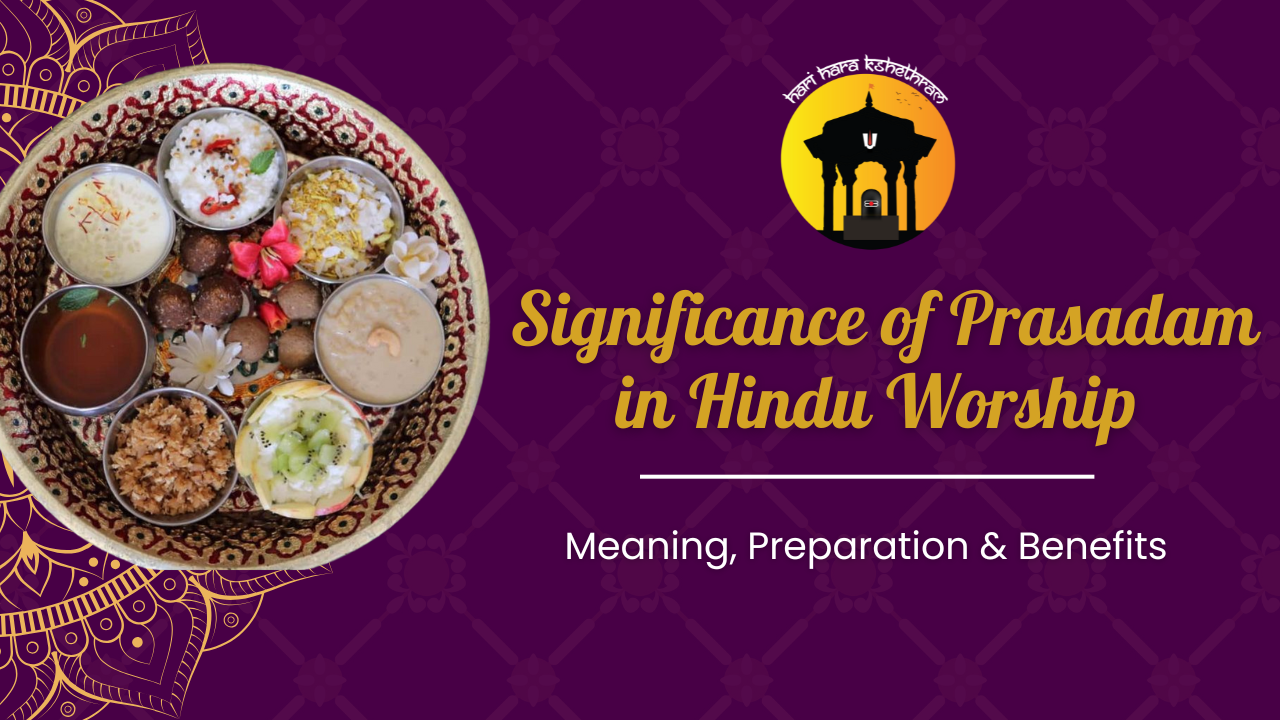Have you ever noticed the peaceful joy that comes from receiving prasadam after a pooja? The significance of prasadam in Hindu worship goes far beyond its taste—it is infused with blessings, devotion, and divine energy.
In Hindu tradition, prasadam represents the sacred food offered to the deity and then distributed to devotees as a blessing. At Hari Hara Kshethram Temple in Austin, prasadam is prepared with love, purity, and adherence to scriptural traditions, making it a vital part of every worship experience.
In this article, you will learn the deeper meaning of prasadam, how it is prepared, and why it holds such spiritual power in Hindu culture.
Importance of Spiritual Preparation
The significance of prasadam in Hindu worship is deeply tied to spiritual preparation. Before preparing or offering food to the deity, devotees bathe, wear clean clothes, and maintain a pure mind.
Cultural practices like waking early, lighting a diya, and preparing naivedyam (offering) before visiting the temple ensure the food is charged with devotion. At Hari Hara Kshethram Austin, volunteers prepare prasadam following these age-old traditions, ensuring it carries both physical nourishment and spiritual grace.
Why a Devotional Guide Matters
For those who wish to prepare prasadam at home, a pooja booklet in English can be an invaluable resource. It explains the correct offerings for different deities, the mantras to chant, and the significance behind each ingredient.
Many temples, including Hari Hara Kshethram, offer these guides in English and regional languages. By understanding the why and how of prasadam preparation, devotees feel more connected to their offerings and receive greater joy in sharing them.
How to Book a Qualified Priest
A qualified Vedic priest can guide devotees in offering prasadam according to scriptural methods. Whether it’s a festival like Ganesh Chaturthi or a personal Satyanarayana Vratham, the priest ensures every offering is performed correctly.
If you are in Texas, you can book a Hindu priest in Austin through Hari Hara Kshethram or arrange for online priest services if you live elsewhere. This ensures your prasadam and rituals align with traditional standards.
Where to Buy Authentic Items
Using pure and traditional ingredients is essential for prasadam preparation. Items like ghee, jaggery, cardamom, and temple-grade rice should come from trusted sources.
You can buy pooja items online in USA from reputable vendors or directly from the authentic Hindu puja store at Hari Hara Kshethram. Supporting such sources ensures that your offerings are both pure and supportive of temple activities.
The Spiritual Benefits of Prasadam
Prasadam is not just sanctified food—it is a channel of divine energy. By partaking in it, devotees receive blessings for health, peace, and spiritual growth. Sharing prasadam with others multiplies the blessings, fostering unity and love in the community.
As the Bhagavad Gita says, “The devotees of the Lord are released from all kinds of sins because they eat food offered first for sacrifice.” This reinforces why prasadam is central to every Hindu ritual.
Bringing Devotion into Daily Life
The significance of prasadam in Hindu worship reminds us that even simple acts like cooking and sharing food can be acts of devotion. Whether at the temple or in your home, the offering of prasadam keeps us connected to the divine in everyday life.
We warmly invite you to visit Hari Hara Kshethram Temple in Austin to experience the sacred preparation and distribution of prasadam during our weekly poojas and festivals. May the blessings of the divine nourish both your body and soul.
FAQS
1. Why do Hindus visit temples?
Hindus visit temples to offer prayers, perform rituals, and seek blessings from the deity. Temples are considered sacred spaces where divine energy is concentrated, helping devotees find inner peace and spiritual upliftment.
2. What should I wear to a Hindu temple?
It is customary to wear modest, traditional clothing. For men, a dhoti or kurta-pajama is ideal; for women, sarees or salwar kameez are preferred. Shoulders and knees should be covered, and footwear must be removed before entering.
3. When is the best time to visit a temple?
Early mornings and evenings during aarti or pooja are considered the most spiritually charged times. Special occasions and festival days also enhance the devotional atmosphere.
4. Can non-Hindus visit Hindu temples?
Yes, most Hindu temples welcome all visitors, provided they respect the customs, dress code, and sanctity of the space. Some temples may have restricted areas for non-Hindus.
5. What offerings should I bring to a temple?
While offerings are optional, devotees often bring flowers, fruits, coconuts, or sweets for the deity. These items are later blessed and distributed as prasadam.



